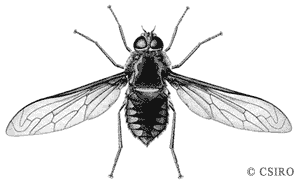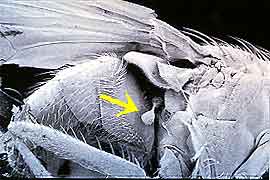|
Diptera:
flies and mosquitoes
Characteristics
This
is one of the largest insect orders in the world and includes many
familiar insects such as mosquitoes, midges, sand flies, house flies
and blowflies. Many species of Diptera are important due to the
role they play in disease transmission, which includes such things
as mosquitoes that spread malaria in many underdeveloped countries.
Diptera can be distinguished by the following features:
|

Comptosia insignis (BOMBYLIIDAE)
|
|
- Hind wings
are reduced to small club like structures called halteres.
The halteres are used as stabilisers during flight
- Sucking
mouthparts, sometimes adapted for piercing e.g. mosquitoes
- short simple
antennae, frilled or bushy in mosquitoes and crane flies
Comptosia
insignis is a member of the BOMBYLIIDAE family. These flies
superficially resemble bees due to their stoutly built bodies which
are covered in hair and their long thin proboscis. This along with
their flight habits have earned them the common name of bee flies.
Adults can often be seen resting on or hovering over blossoms or
patches of bare ground in sunny locations. Adult bee flies feed
on nectar from a wide variety of flowers and may be important plant
pollinators. Although little is known of the Australian species,
the larvae of bee flies are believed to parasitise the larvae of
other insects and may prey on the eggs in egg-masses of grasshoppers
and locusts.
The small club-like
halteres,
as seen here are situated behind the much larger forewings. The
base of halteres are flexible and when they are moved a fly or mosquito
is able to control its flight. As the haltere bends at the base,
a fly or mosquito can change flight speed or direction making them
more manoeuvrable compared to many other flying insects.
Life Cycle
Flies
have a complete
life cycle and will mate while flying. The eggs are usually
laid into suitable substrate or close by an appropriate food source.
The larvae complete their development and pupate in the substrate
where they were laid, which may be soil, organic matter, water,
plant tissue or animal tissue.
Feeding
Adult
flies are only able to ingest liquid foods due to their sucking
and/or piercing mouthparts. In most species digestion is partially
external and salivary secretions are introduced to liquefy the food
and then the softened product is mopped up. Species such as mosquitoes
and March flies pierce the skin of their prey with their proboscis
and then suck up the blood.
The larvae of
this insect order mostly feed on moist, decomposing food items such
as carrion, fungi, dung and rotting vegetable matter although some
are predators or parasites of other animals.
Habitat
Members
of this order of insects are found in almost all types of terrestrial
and freshwater habitats across Australia with forests and the margins
of water bodies having the greatest diversity of species.
|



